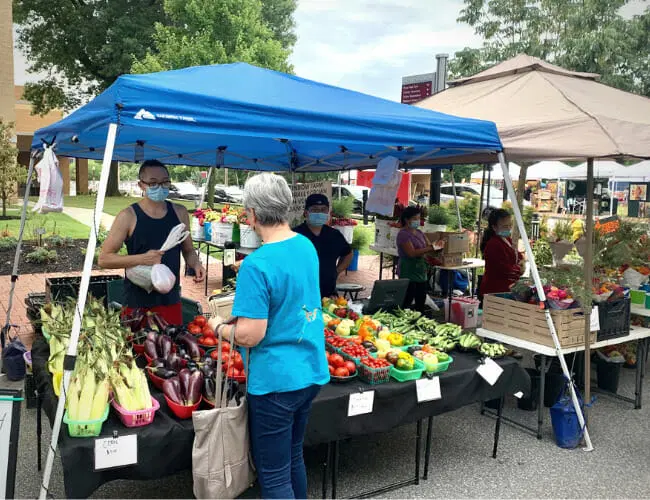The local farmers market isn’t just a great day out for the family or for environmentally conscious shoppers.
If you’re a farmer or food producer, the local village market can be a great opportunity to diversify your business, connect directly with customers you wouldn’t otherwise reach, and make some extra profit, all whilst doing something that can be fun and sociable.
So how can you get a spot at your local farmers market and what do you need before you can start selling your own produce?
Today we’re going to be breaking down the whole process on how to sell at a farmers market, from licensing requirements to hints and tips that can help you promote and sell as effectively as possible.
How to Get a Stall at a Farmers Market
The distinguishing feature of a farmers’ market, and one of the main reasons that customers are drawn to them, is that stall-owners will usually be local producers who have grown and harvested the food themselves, or who have produced food using locally sourced ingredients.
To be a certified farmers market in the UK, you usually have to show that your vendors can all be grouped under this category.
Market traders who are simply reselling items or food products that have been produced elsewhere or purchased wholesale are unlikely to find themselves a place at an authentic farmers’ market.
Other than this, the precise requirements to sell at each market can vary from place to place, and you’ll have to check with your local farmers’ market website or the market manager to find out specifics.
Most will have a specified distance from the market within which vendors must be based.
For some markets, this radius can be set in miles. For others, it may follow county boundaries. Markets in large and busy urban centres tend to have larger areas from which they draw their sellers.
If all this sounds applicable to you, then what’s the next step in getting yourself a stall at your local farmers’ market?
We’ll deal with licences and permits in a moment, but in terms of getting a spot at the market itself you’ll need to speak with the market management team.
Check whether they have any vacancies and whether there are any gaps in terms of produce being offered. There may be a waiting list for stalls, particularly at the most popular markets.
It’s a good idea to have visited and familiarised yourself with the market beforehand. That way you’ll already have an idea of what’s being sold there, helping you to select and pitch your product more effectively to the organisers.

Do You Need a Licence to Sell at a Farmers Market in the UK?
At the same time as vying for a spot at the market itself, you’ll need to ensure you have the correct licence.
In the UK, you need a licence from the local council in order to be a certified market trader.
Licences are usually either temporary or permanent licences, and often come with stipulations as to where and when you can sell, as well as other possible guidelines relating to the size of your pitch.
How long a temporary or permanent licence lasts will depend on the council, so it’s best to talk directly with them or to look up details online in order to get accurate information for your area.
One thing is for certain though – no licence, no legal market trading. Farmers’ market managers are unlikely to let you pitch up without the necessary paperwork and if you are found to be trading without council permission you can face hefty fines, seizure of goods, and even custodial sentences if you’re a repeat offender!
What Permits Do I Need To Sell at a Farmers Market?
In addition to your traders’ licence from the council, there are likely to be a number of other certifications and approvals required before you can actually start selling produce directly to customers.
If you are intending to sell any manner of food, whether raw or cooked, you will need the approval of your local Environmental Health agency.
This is also run via your local council. It’s best to contact them as early as possible in the process of establishing a market stall.
There are various requirements for different food stuffs, ranging from the temperature at which produce has to be kept, to cleanliness in preparation and serving areas.
Your local Environmental Health Officer should be able to provide you with any particular certifications or checks that you need to pass, but at a minimum you’re likely to require at least a Level 2 food hygiene certificate.
Food hygiene certificates can often be completed either online or at local colleges and training centres. Lower levels, such as Level 1 and 2, are often inexpensive (between £10 and £150) and only take a few days to complete.
Your Environmental Health officer is also likely to request a Hazard Analysis and Critical Control Point (HACCP) Plan.
This is a plan which identifies points in your food management system which could fail and cause potential danger to customers, as well as steps you can take to deal with these issues if they occur to safeguard the public.
Trading Standards also have a set of regulations and requirements when it comes to the measuring, labelling, and selling of food stuffs.
Make sure you are well versed in any specifications relating to the products you’re planning to sell, as a flash visit from a Trading Standards officer could result in stall closure and fines if you’re in breach of any regulations.
Finally, in addition to showing evidence that you’re aware of and adhering to statutory guidance, individual farmers’ markets may require additional evidence of risk assessments, or at the least, a familiarity with the market’s own risk management process.
What Do You Need to Sell at a Market?
OK, so you’ve got your trader’s licence, your approval from Environmental Health, and your allocated spot. But what do you actually need to sell effectively once the farmers’ market opens its doors to eager customers?
Each pitch will be different, but as a general guide, expect to have to bring practically everything yourself.
Don’t assume that the market will provide even the most basic of equipment and check carefully about whether amenities such as electricity are provided.
Many market traders find that they’ll need a minimum of the following, in addition to the produce that they’re planning to sell, of course:
Tables with Coverings and Product Stands
It’s worth investing in a sturdy, collapsible set of tables for your wares. Remember, successful market traders are likely to come back week after week, so any furniture you use is going to have to put up with a fair amount of punishment, being set up and packed away multiple times.
Think about what you want to cover your table with, as a bare surface can look unattractive and become messy easily.
You may also want various stands or platforms to elevate different products and to make the most of your space.
Storage for Your Produce
Do you need refrigeration for what you’re selling, or can you have stackable boxes to keep additional stock in?
Remember, your customers are likely to be able to see some of your spare stock, so try to pick storage that’s as attractive as possible.
Old, mismatched boxes and carrier bags aren’t necessarily a look you want to go for.
Shelter
Some markets may provide awnings or sheltered tent structures, but many will not. Your shelter needs to be sturdy and safe, so don’t be tempted to cut corners with this one.
Check the size requirements of your pitch carefully and make sure you don’t accidentally invest in a shelter that will prove too big for what you’re allowed.
Marketing Material
Signs, labels, flyers, banners – you’ll need to bring them all with you. Some market traders love chalkboards for their ability to write and rewrite things on them, but you’ll probably also want a few sturdier, weatherproof banners and signs that don’t need to be rewritten every time you go to market.
Stationary and Tools
Experience will tell you what you need and what will come in handy, but as a starting guide it’s a good idea to pack plenty of gaffa tape, cable ties, pens and pencils, spare paper, scissors, a calculator, and plenty of cutlery if your produce demands it.
If you’re serving samples, do you need plates, bowls, or cocktail sticks?
Food and Water
You don’t want to miss potential custom by having to dash to the food trucks every time you get peckish or thirsty. Make sure you pack plenty of snacks and fresh water to keep you hydrated and on your feet.
Credit / Debit Card Reader
Modern customers increasingly expect market traders to offer card transactions. You’re cutting off a major revenue source if you decide to stick to cash only, even if it does feel like less hassle for you.
Some people simply don’t carry cash on them, particularly if they’re not used to traditional markets.
Cash and Plenty of Change
That being said, many old-school market customers will still want to be able to trade using traditional legal tender! Make sure you pack a float with plenty of change so that you’re not scrabbling to beg coins from a fellow trader.
A Comfortable, Functional Seat
Finally, standing on your feet throughout a market session can be a tiring experience.
Make sure you and your staff have somewhere comfy to sit down and rest during quiet periods, ideally in chairs or stools that can allow you to jump up quickly when a customer arrives.
Tips for Selling At a Farmers Market
Having the materials and produce alone won’t necessarily ensure you’re enticing customers and turning a profit.
Slow periods of business can happen to any market trader, and you have to be ready to ride the ebb and flow of market day, but there are some things you can do to maximise your chances of making your stall a profitable one.
Think Carefully About The Produce You’re Offering
There’s little point setting up a stall that, to the eye of the roving customer, looks practically identical to a number of other stalls in the vicinity.
In fact, many market organisers will try to ensure that new, incoming traders compliment the existing stalls at a market by offering something a little different, or filling a gap that needs filling.
The aim for most markets is to provide visitors with a shopping experience that allows them to buy as wide a variety of produce and groceries as possible, in an attempt to contend with the convenience of supermarkets.
If you’re offering a specific product, such as cheese, flavoured cordials, or jams, consider offering something a little out of the ordinary, or at least having some products that cater to the adventurous.
Unusual flavours that catch the eye of enthusiastic homecooks, or clever twists on classic recipes, can go down a treat with market crowds, as well as drawing people in to consider some of your more traditional products.
Make Clear, Attractive Signs and Promotional Material
From a distance, signs need to be clear, simple, and enticing. Up close, customers are likely to want more information about your products.
Consider smaller, more detailed labelling for goods that shoppers can peruse at their leisure, leaving the larger signs for promotions and competitive prices.
Clarity is important. People like to know how much something costs and what they’re getting for that price. Don’t make people ask questions that you can answer with a few clear signs, as not all shoppers feel comfortable striking up a conversation.
Finally, consider your branding as well as promotional material that you can give away. Markets can be a great opportunity to signpost people towards social media, or to provide them with leaflets about other products you might offer outside the market itself.
It’s also worth investing in a professional banner, something simple but memorable, which will help cement your identity at the market over time.
Remember, many farmers’ market patrons are repeat visitors, so establishing a reputation within the market is a vital part of staying profitable.
Confident branding and appropriate advertising using the materials you bring with you can play an important role in this regard.
Keep Your Stall Well Stocked
Shoppers can be put off by empty space on a stall table. It can make your produce appear unwelcoming, isolated, and lacking in energy.
Even if you are only selling a few products, try to design your sales space to minimise blank surfaces.
You can either make sure there are plenty of items on show at once, stocking up the table to give a sense of plenty, or you can use vacant space to hold promotional material, photographs of your production process, and other customer-friendly information.
Be Friendly, Approachable, and Cheerful
This is a crucial aspect of being a popular and successful market trader.
Many people come to the farmers’ market looking to have a chat with food producers and local business owners, so feeling comfortable talking to the public, or at least being willing to build that confidence, is important.
Smile, don’t be afraid to ask customers if they’d like to know more information, and try not to look disinterested or bored by staring down at your phone.
If standing stiffly watching customers go by feels awkward to you, keep yourself busy with stall related tasks, such as ordering the stock, preparing samples, or tidying things up.
Try not to look so busy that people don’t want to disturb you, but a bit of activity can bring a sense of life and purpose to your stall, and can make people feel a bit more at ease as they browse your wares.
Consider Offering Free Samples
Free samples don’t always lead to a sale. In fact, the vast majority of samplers will walk on and not buy anything. If this is the case, why bother from a business perspective?
Offering free samples can lend a friendly atmosphere to your stall and can encourage customers who wouldn’t necessarily stop to approach.
This, in turn, gives you the opportunity to engage them in a bit of friendly conversation which could, if the stars align, lead to a few extra sales.
But one of the main plus-sides of offering free samples is that it encourages foot traffic to linger by your stall. Stalls are like restaurants – busy stalls attract people, empty stalls deter them.
At a farmers’ market, particularly during quieter periods, seeing a few people milling around a free sample tray can be enough to make a passing shopper want to see what all the fuss is about. The more curious shoppers congregate, the more curious shoppers are drawn in.
In other words, the people trying the samples might not always be the people who end up buying your product, but their very presence can help draw custom to your door.
Consider Pre-Packing and Pre-Pricing Certain Products
Try to make the sales process as stream-lined as possible. Customers might not always feel comfortable asking you to cut them off a slice of cheese, so why not have a few pre-packaged items ready to go, with a clear and easy price-tag for people to read?
Not only does this encourage faster sales and helps keep things efficient during busy periods, it also gives you something to do during quieter spells, helping to keep you and your stall looking busy and bustling.
Give Yourself Plenty of Time to Set Up
If the market opens its doors at 8am, make sure you’re ready to go at 7.45am. You don’t want to be scrambling to assemble your wares just as the first customers filter through, especially since some of the keenest shoppers can be the ones who arrive earliest in the day.
If it’s your first time at market, consider setting up your stall on your own property a few days beforehand.
Not only will this give you a sense of how long the whole set-up can take, it will also allow you to play around with the display and see how everything might look from a customer’s perspective.
How Much Does it Cost To Sell at a Farmers Market?
As far as trading premises go, farmers’ markets can offer some of the lowest overheads going. That being said, setting up as a market trader doesn’t come without its costs. Some of the largest expenses may come before you’ve even had your first day on your stall.
Pitches themselves are usually relatively affordable. Once you’ve been given the green light by the market’s management team, your place could cost anything from £20 for a patch at a very small, community market, to upwards of £100 for more popular, bustling farmers’ markets.
Seasonal markets can cost prospective traders even more. Generally speaking, the higher the foot traffic, the more your pitch is going to cost.
As a public-facing trader, you will require public liability insurance. For market traders, this could cost anything between £50 to £250 a year, depending on your coverage.
The licence from the council is often the most expensive element, especially when it comes to initial costs.
These can come to £1000 to £3000 a year for permanent licences. Weekly fees are also sometimes used for temporary licences. Contacting your local council is the only way to find out how much it could cost you.
Finally, there are other start-up costs worth considering. You will want to invest in a sturdy, reliable set of tables, awnings, awning poles, and storage equipment, not to mention any cutlery, refrigerators, and other tools required.
It’s difficult to estimate these costs, but high quality goods could add up into the thousands.
If you plan on employing staff to help you out, this will of course involve ongoing wages.
Is Selling At a Farmers Market Worth It?
It can be difficult to turn a tidy profit every time you set up stall at a farmers’ market. Even with the best product, the best marketing, and the best planning, there are a range of factors outside of a trader’s control that can turn a promising pitch into a disappointing day.
Weather, local tourism patterns, and luck can all factor heavily in how successful any given market day is.
Farmers and local producers are unlikely to support a business through farmers’ market stalls alone, though that’s not to say this isn’t managed by some.
What’s more common is for local producers to use farmers’ markets as avenues for extra income, as well as great platforms to diversify their business and connect with the local community.
Producers of food can also enjoy relatively high mark-ups by selling directly through the market, whilst still being able to offer competitive prices to customers.
Furthermore, farmers’ markets can be a fun, energising way to reach customers that you wouldn’t usually reach, helping to get your products out there and seen, without having to rely on middle-men, wholesalers, costly distributors, or marketing companies.
With a growing public demand for organic, locally sourced, fresh and healthy produce, the local farmers’ market could well prove to be the next best step your business can take.



